#bldhaven
Explore tagged Tumblr posts
Text

We all wear masks. It's just that some of us have seen what's underneath.
#dccomics#batman#superhero#batmanandrobin#batmandccomics#batmantheanimatedseries#comics#cool#dark#dc#dickgrayson#gothamcity#justiceleague#logo#logodesign#nightwing#pyrography#robin#superman#thejoker#vigilante#woodburn#bldhaven#dccomicsfanart#nightwingbatman#nightwingdickgrayson#nightwingdccomics#grungeaesthetic#art#cute
24 notes
·
View notes
Text
A (Negative) Review of Tom Taylor's Nightwing Run - What Went Wrong? Bludhaven (PART 2)
Introduction Who is Dick Grayson? What Went Wrong? Dick's Characterization What Went Wrong? Barbara Gordon What Went Wrong? Bludhaven (Part 1, Part 2) What Went Wrong? Melinda Lin Grayson What Went Wrong? Bea Bennett What Went Wrong? Villains Conclusion Bibliography
Instead, Taylor readily abandons the statue just as soon as it is introduced. We don���t return to it, we don’t even use it as a set piece that can ground Bludhaven and make it feel like an actual place. It doesn’t make an appearance in any covers, nor in establishing shots. In fact, even its thematic symbolism is forgotten when Alfred’s statue is built. Such a decision is especially infuriating when one considers the fact that not only would Alfred hate having a statue in his honor, but that Alfred means absolutely nothing to the people of Bludhaven. He means something to the reader, but not the citizens of the city that Dick is meant to protect. In this, we see how once more Taylor’s online mindset interferes with his storytelling, replacing a set piece that was tied to the in-universe history of the city he was writing with fanservice.
By contrast, Humphrie’s Bludhaven is filled with specific locations that are unique to, well, Bludhaven. We have the different casinos
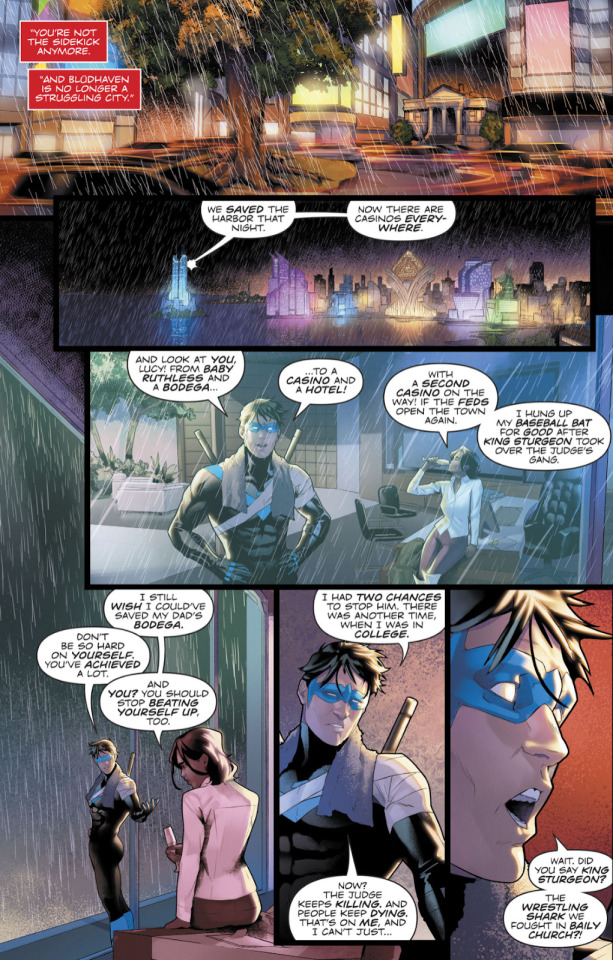
(Humphries, Sam. Ruthless, writer. Janson, Klaus; Campbell, Jamal, illustrator. Nightwing: Rebirth no. 37, e-book ed. DC Comics, 2018. pp. 22)
The Tiki District
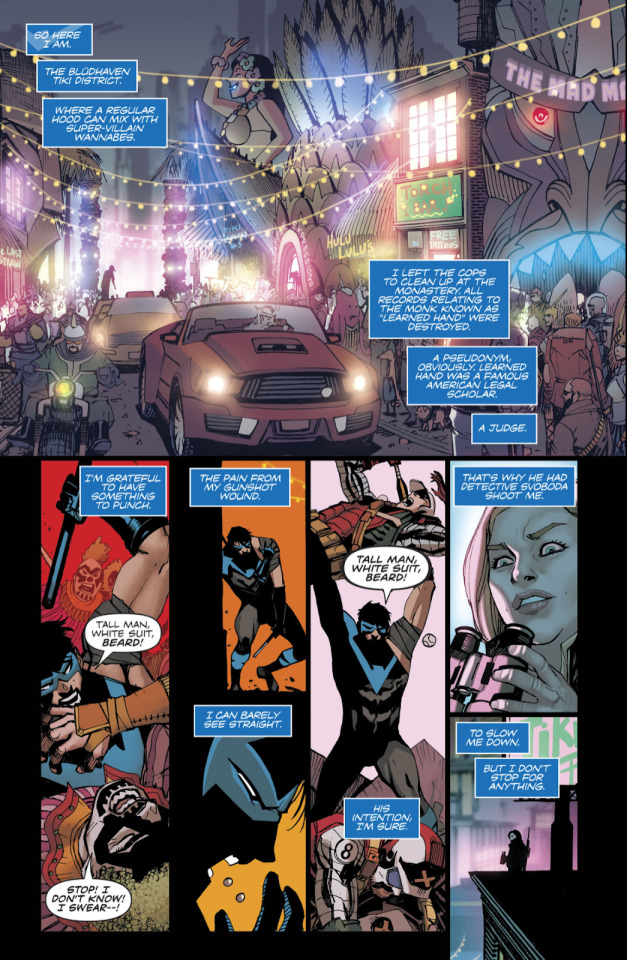
(Humphries, Sam, writer. Chang, Bernard, illustrator. The Untouchable: Chapter Two: Relentless. Nightwing: Rebirth no. 36, e-book ed. DC Comics, 2018. pp. 13)
Which greatly contrasts the darkness of the docks…
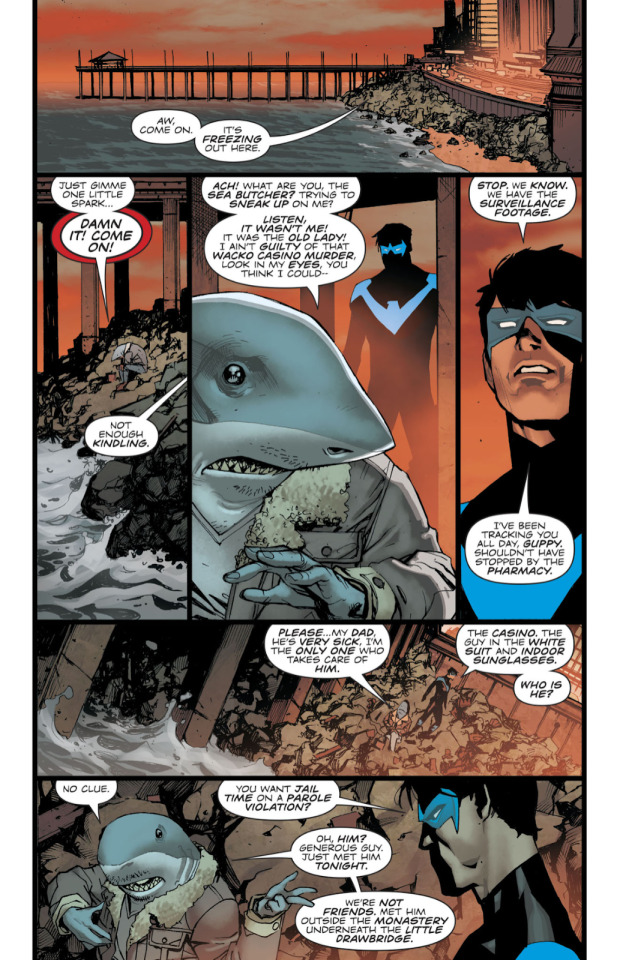
(Humphries, Sam, writer. Chang, Bernard, illustrator. The Untouchable: Chapter One: Hunter. Nightwing: Rebirth no. 35, e-book ed. DC Comics, 2018. pp. 17)
And the melancholy of the sunken city
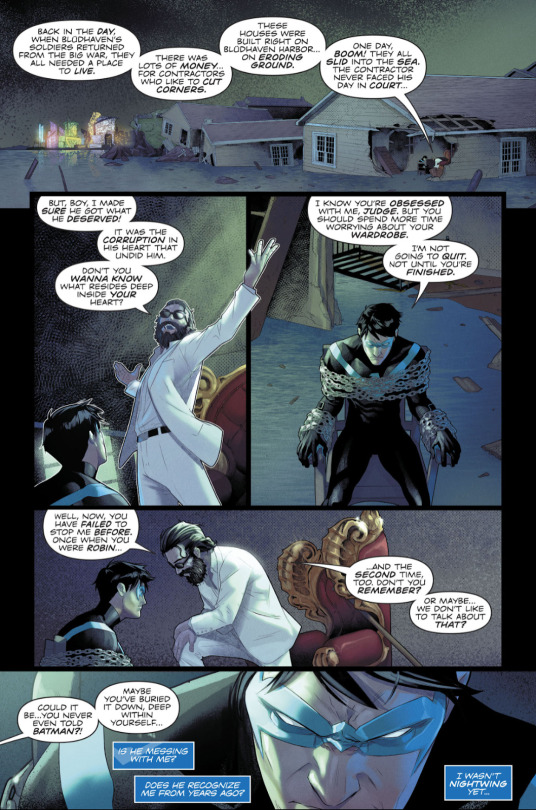
(Humphries, Sam, writer. Jimenez, Phil; Campbell, Jamal, illustrator. The Untouchable: Chapter Five:Face Off. Nightwing: Rebirth no. 39, e-book ed. DC Comics, 2018 pp. 05)
All of it is so specific that it makes Bludhaven feel alive. It gives Bludhaven an identity rather than keeping it a generic location.
Let’s take a closer look at the establishing shot of the sunken city and see how the page is laid out to emphasize the storytelling going on in the dialogue and enrich Bludhaven. There's something so visually poetic about that last panel. The intimacy between the Judge and Nightwing, the opulent throne atop a simple boat in a sunken, destroyed home.
It feels a bit like a visual metaphor for Bludhaven and corruption. Bludhaven is thriving because of the casinos, but they are also corrupt. And yet, despite their rich aesthetic, they are built on top of a tragedy, of a city that was lost and had to rebuild itself, taking advantage of a corrupt system that devastates its citizens while also being the only thing keeping them from drowning.
The lighting of the page is also so beautiful. Light coming in from above, appearing almost heavenly, and yet it makes the scene so still and lonely
During Dixon and Grayson’s runs, and during Taylor’s run, Bldhaven does not have an identity outside of Gotham and Nightwing. It is difficult to describe it without relying on those two factors. It is not impossible, of course, but those descriptions would be rather bare, relying on what one wishes Bludhaven could be rather than what is actually on the page.
In The Untouchable, however, Bludhaven can be described independent of Gotham and Nightwing. Yes, those elements are still crucial to its depiction, but rather than being all that there is to it, they serve to enhance what is already there. Dick’s interactions with people from Bludhaven further fleshes out the city while also demonstrating that they have their own lives outside of their meetings with Dick or Nightwing. Guppy, Svoboda, Lucy, Dick's clients at his gym... All of them are clear products of Bludhaven, they are affected by what happens in Bludhaven, and they interact with different parts of Bludhaven. Because they are characters with their own interiority, the reader really is able to feel the consequences of the Judge's actions.
Yet, Taylor and Redondo both refuse to pay Bludhaven any of the attention it deserves. They do not even give it the respect of making it into Gotham-light. Instead, they opt for the generic, lazy, and morally simplistic depiction that is yet more proof of just how little thought they give to anything remotely related to Dick Grayson.
Bludhaven, as it exists in The Untouchable, was built on top of a corrupt foundation, and its systems are so intertwined with the rot that you can't neatly separate them. There's no easy answer to this, no solution without a victim. It adds some nice stakes to the story, creates constraints which Dick must creatively work around, and demonstrates how Nightwing’s fight is far larger than just The Judge. It illustrates how even if Dick catches this one guy, he still has so much more to do, creating a perfect comic status-quo where the hero can progress and make a difference without eliminating conflict sources for future stories.
Through the Judge, we also get to see Bludhaven’s history, and through this evolution, we also get to see just how much Humphrey cares about Bludhaven. I have yet to encounter another writer who has devoted so much care to Dick’s city. I have yet to encounter a writer who put so much effort into making this city feel alive. Gotham is beloved by many writers and fans alike, and The Untouchable showed that Bludhaven has the potential to be just as great if only it was given to a writer who cares enough to develop it.
Needless to say, Taylor is not that writer.
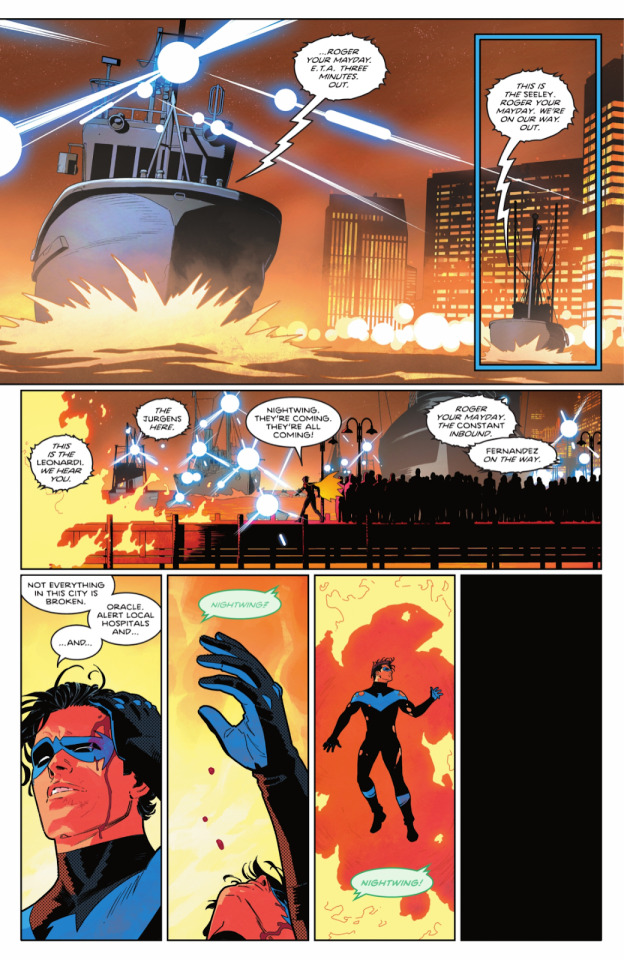
(Taylor, Tom, writer. Redondo, Bruno, illustrator. Leaping into the Light Part 4. Nightwing: Rebirth. 81, e-book ed. DC Comics, 2021. pp 13)
While this may be wholesome, the truth is that by giving such a triumphant moment early on in the story, Taylor robbed his characters of any opportunity to change, and any opportunity for a well-earned pay off later. In turn, this robbed the story of its ability to engage with its themes by creating a very simple morality. Evil can be manifested in different ways and anyone is capable of it. Perhaps not all of us will be uppercase Evil, but we're all capable of the smallest acts of lowercase evil by letting our anger blind us to what is right, not helping others because we tell ourselves we have to survive, upholding unfair systems because they benefit us.
The city of Gotham does something similar. We have the evil of the rogues, but we also have the crime families, a myriad of corrupt institutions -- from the police department to the justice system to the politicians who are in the pockets of those on the top – and the ordinary citizens who have been disillusioned by the hardship they face. We have greed on a massive scale but also a small and personal one that is far more relatable, we have chaos of the Joker and we have more relatable pettiness, selfishness, apathy, and cruelty.
Some of these play a larger role than others, their influence has a wider reach, but it is the different layers that makes Gotham feel so difficult to tackle. There’s a reason why Batman's origin story works best when it's just about a mugging gone wrong, and when Joe Chill is just a simple man who fired two shots in a dark alley because he wanted a pearl necklace. There's a reason why Bruce stays in Gotham rather than trying to save the entire world all the time. Batman, after all, is not about fighting the just grander Evil, but about bringing justice to everyone, even in what may be perceived to be a small scale.
While I do not believe Batman: The Knight was perfect (and, indeed, I have a lot of problems with it and dislike Zdarsky’s current Batman run nearly as much as I dislike Taylor’s Nightwing), I do think that Zdarsky did a good job when having Ra’s Al Ghul confront Bruce on this matter.
In #09, Ra’s challenges Bruce to work on a macro scale, and Bruce explores that idea before deciding he needs to work on a more personal level.
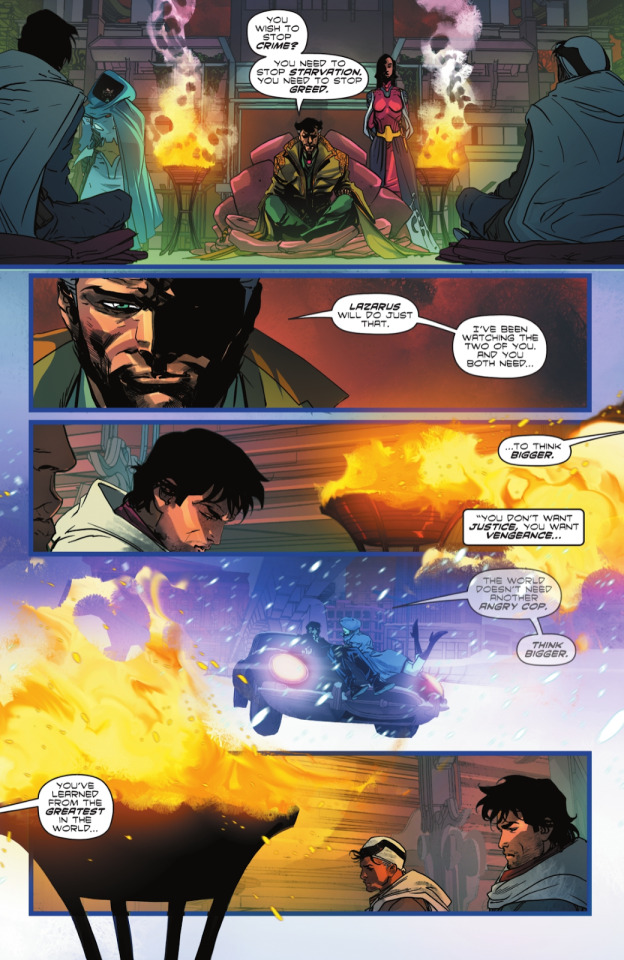
(Zdarsky, Chip, writer. Di Giandomenico, Carmine. The Knight Part 9. Batman: The Knight. 09, e-book ed. DC Comics, 2022. pp 13)
Bruce’s world did not fall apart because of a war or an alien invasion, but that did not mean his pain is invalid. There might be far more important things than catching a mob boss who orchestrated the murder of two circus acrobats, but that doesn’t mean that their lives did not matter or that their son does not deserve to see justice. One of the beautiful things about the detective stories of Batman and of Nightwing is that they treat everyone’s trauma with equal respect. Batman and Nightwing aren’t just about catching the bad guy, they are about giving the victim a chance to heal by offering them closure.
You can also observe the dichotomy of these two evils in The Untouchable. The entire plot of The Untouchable is about the Judge using people’s desires to corrupt them, luring them into committing evil deeds. At the same time, the story does not condemn those who fell prey to the Judge’s promises. Instead, it portrays them as complex individuals, and this reaffirms the themes of corruption through desire and the necessity for forgiveness.
Lucy, for example, is not vilified for betraying Dick. She did the Judge’s bidding, but she is not a bad person. She is still Dick’s friend and cares deeply for him. And yet, her choices are not portrayed as excusable. The comic perfectly balanced having Lucy not be a bad guy for what she did while also making it clear that she was still in the wrong for accepting the Judge’s offer. She is not Evil but she made an evil choice and she needs to be held accountable for that.
This plays into the idea that to Dick, people are not naturally Good nor naturally Evil. They just are who they are, they have the potential for both, and it's their choices that dictate their nature.
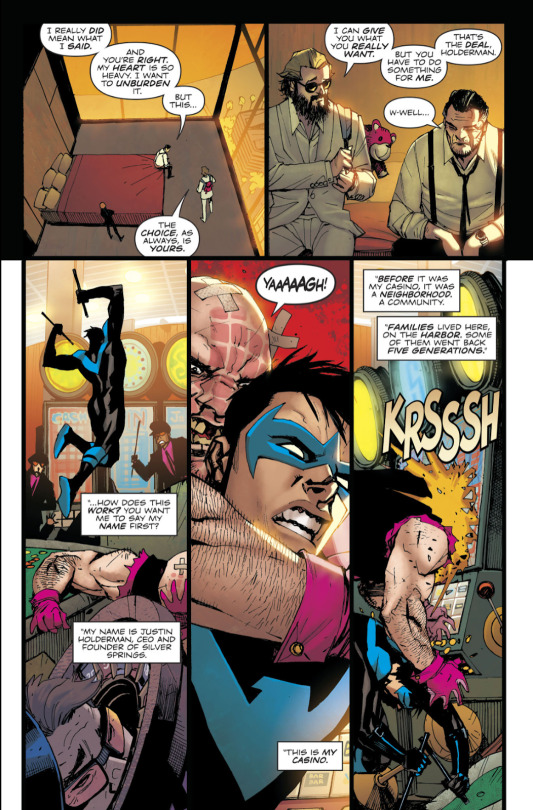
(Humphries, Sam, writer. Chang, Bernard, illustrator. The Untouchable: Chapter Six: Deep Dive. Nightwing: Rebirth no. 40, e-book ed. DC Comics, 2018. pp. 18)
And as mentioned previously, Grayson also played with such ideas when she introduced the character of Sophia into the story.
Taylor flirts with similar ideas without ever committing to them. His Bludhaven supposedly has corrupt institutions, big men on top who oppress others in order to stay rich, but to lay every wrong and every sin in the city at Blockbuster’s feet is morally simplistic. It's flattening. Immature. It's, frankly, boring. It just doesn't work on a narrative level. Most importantly, it makes Nightwing's presence superfluous.
Once more, I must emphasize that I do not believe that one must incorporate a social commentary in the themes of one’s story. However, as Taylor's narrative seems to signal he wants to discuss these matters, I think it is only fair to point out how his actual writing is uninterested in examining the complications inherited in these subjects. Taylor wants those big, meaningful moments that claim to say something thematically important, yet he creates easy-to-take down strawman villains who can take the blame for everything while wrapping them in the trappings of social commentary.
Nothing in Taylor's supporting characters, conflicts, villains, or city were created to challenge Dick in any way. Part of the reason why you can feel Bruce's genuine love for Gotham is that that city is always challenging him, always giving him a reason to give up, but Bruce never does. Again and again, Gotham shows itself as a place that perhaps should not be saved, that is too rotten, literally cursed to bring out the worst of humanity. It would be easier to burn the whole thing down and start new.
But Bruce doesn’t do that. He still sees something in Gotham worth saving. No matter what he uncovers, Bruce won’t give up, and that makes us, the readers, root for Batman and root for Gotham.
Bludhaven should challenge Dick in a similar way. But in this run, it doesn't. Dick's assertion that the citizens of Bludhaven are good and there are only a few bad apples ruining it for everyone is never challenged. Dick is never asked to question his beliefs. When he decided that the solution to one of Bludhaven's biggest problems (homelessness) was just to create a shelter, Dick is never challenged for his savior mentality, he never faces push back from those above him or below, is never paralyzed by bureaucracy, never has to deal setbacks that force him to re-strategize. He's just... Proved right. And everything goes on smoothly.
Taylor’s approach gives Dick no room to grow and no room to stand his ground. I can’t help but think how much more powerful Dick’s own belief in Bludhaven and its people would have been if, during that earlier scene when the tent city was in flames, no one came to help. Nightwing and Robin would have had to save everyone on their own, and Dick would be faced with the difficult to swallow possibility that maybe he’s wrong. Maybe the people of Bludhaven are too disillusioned to do good. Maybe Babs and Tim, both characters who are known for being pragmatic, would even tell him so. But he refuses to accept that. As he looks upon the octopus statue, Dick affirms the resilience of the city and how it does not need to come at the cost of kindness. Bludhaven is worth saving, its people are worth saving, and Dick will continue to believe in them, even though he was just given a reason not to.
Again, I must emphasize that it is fine if a person is not interested in writing a story about this. Not every superhero story needs to explore these real-world, complex themes. One of my personal favorite Batman stories (and one I believe should be required reading for any Batman fan) is Murderer/Fugitive. While there are certainly themes of forging of identity, the story is far more concerned with what the forging of one’s identity means in the specific context of Batman rather than that of the real world. That is not to say you couldn't do an analysis on identity about Murderer/Fugitive, but the work as a whole serves more as a commentary on Batman, and it is in conversation with the popular idea that "Bruce Wayne is the mask that Batman wears."
And just because one wishes to engage with themes of class and economic inequality, it does mean one needs to tackle it directly. Again I must bring up the modern masterpiece that is Scott Snyder’s Court of Owls. That story beautifully uses the fantastical and noire elements of the Court and the creation of the Talons to engage with themes of wealth inequality and to explore Bruce’s complex relationship with Gotham. The secret cult, of superhuman assassins, and the murder mystery element provide enough distance between the real world issues and the story itself that Snyder has the creative freedom to play with his characters and narrative while the specificity allows him to dig deeper than he ever could should he have decided on going for a broad approach.
Taylor tries to ground his themes by using real-world issues, but he refuses to engage with what those real-world issues look like in, well, the real-world. He deals with them in the context of his morally simplified, perfect little society. As Braxis perfectly pointed out “When Dick starts a charity to help the homeless he never actually explains how that will be done, what causes homelessness, or what the homeless are asking for support.” (Braxi, Steve, “On Superman, Shootings, and the Reality of Superheroes” Comics Bookcase, September 2021)
Taylor’s Bludhaven demonstrates a frustratingly simplistic view on morality that prevents the story from engaging with these issues with the care they deserve. By not fleshing out the city, by denying Dick’s interactions with other characters, Taylor creates a world of simple morals. This means that rather than engaging with the progressive ideology he claims to care about he is simply creating the appearance of social commentary and rich themes. This demonstrates that he’s not actually interested in the work required to make that work, only the prestige that comes from it.
42 notes
·
View notes